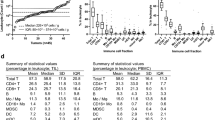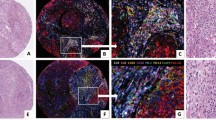Abstract
Serial frozen sections from eleven patients with malignant breast tumours and five patients with benign disease were studied by indirect immunoperoxidase using a panel of mouse monoclonal antibodies to human leucocyte antigens. More infiltrating leucocytes were seen in tumour sections than those of benign conditions. A considerable proportion of the infiltrating cells were T cells, and more of these were of the suppressor/cytotoxic subset than the helper/inducer subset. The T cells were apparently not all activated as indicated by lower levels of staining with anti HLA-DR than anti-leucocyte antibody. Diffuse staining was sometimes seen with HLA-DR and T cell subset antibodies. Tumour cells did not stain or were only very weakly positive with anti HLA-A, B, C.
This is a preview of subscription content, access via your institution
Access options
Subscribe to this journal
Receive 24 print issues and online access
$259.00 per year
only $10.79 per issue
Buy this article
- Purchase on Springer Link
- Instant access to full article PDF
Prices may be subject to local taxes which are calculated during checkout
Similar content being viewed by others
Rights and permissions
About this article
Cite this article
Rowe, D., Beverley, P. Characterisation of breast cancer infiltrates using monoclonal antibodies to human leucocyte antigens. Br J Cancer 49, 149–159 (1984). https://doi.org/10.1038/bjc.1984.27
Issue Date:
DOI: https://doi.org/10.1038/bjc.1984.27
This article is cited by
-
CD4+ T lymphocytes infiltrating human breast cancer recognise autologous tumor in an MHC-class-II restricted fashion
Cancer Immunology Immunotherapy (1995)
-
The Immunology of Breast Cancer
Clinical Immunotherapeutics (1995)
-
Study of the relationship between immunohistologically demonstrated lymphocytes infiltrating human breast carcinomas and patients' survival
Journal of Cancer Research and Clinical Oncology (1991)
-
Sparse distribution of γ/δ T lymphocytes around human epithelial tumors predominantly infiltrated by primed/memory T cells
Cancer Immunology, Immunotherapy (1990)
-
Alterations of class I HLA genes in human colon cancers
Human Genetics (1988)



